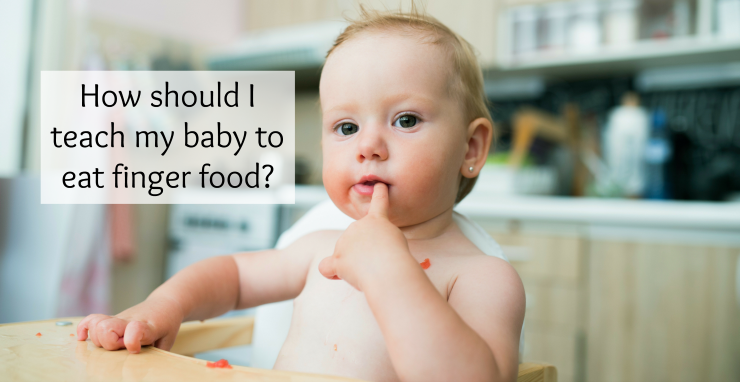How Should I Teach My Baby to Eat Finger Food?
May 11, 2017
A mom in our KidNurse Community had a great question about how to teach a baby to eat finger food. It’s a question many of my patients’ parents have asked over the years, so I want to share my answer here along with a few tips to help all of you whose babies are getting ready to feed themselves.
KidNurse Community Question: My question is, are there any techniques I can do to help my 10-month-old son feed himself? His pincer grasp is there, I just think he is not motivated. I let him be messy with his food and all he does is play with them with his hands but hardly puts them in his mouth. He will swipe everything off his tray and cry for me to feed him. It is very frustrating. Please help.

How Should I Teach My Baby to Eat Finger Food?
Learning to eat finger food is an important part of your infant’s development. To pick up food, babies need to develop a pincer grasp (the ability to grab something using their thumb and forefinger). Some babies may need a little extra encouragement, and that is totally normal.
It’s important to give your baby time as they tackle this new skill. Babies learn to feed themselves over several months, and it takes a lot of teaching and patience from their parents. Usually babies conquer finger food with the pincer grasp between 9-12 months and then a spoon between 15-18 months.
Here are a few important tips when it comes to teaching your little one the very important skill of feeding him or herself!
1. Practicing the pincer grasp can happen outside of mealtime. I’d encourage you to practice with your baby during playtime, as well. Small toys that are easily grabbed will help strengthen and develop little fingers.
2. Try not to pressure yourself too much, because remember, until 12 months, the majority of your baby’s food will be from breastmilk or formula. Solid foods and finger foods are additional, and encouraged to help add a few extra calories while your baby learns a new developmental skill.
3. During which meal is your baby usually the happiest and most engaged? Also, what meal do you have the most time to spend working on new skills? Whether it is breakfast, lunch, or dinner, pick that meal to focus on offering finger foods.
Sometimes focusing on more than one or two meals a day to teach finger foods can become time consuming and slightly stressful. We want to teach babies this new skill in a calm environment when they are alert and happy.
4. Give your baby appropriate finger foods. Here are some suggestions:
- Avocado (sliced or cubed)
- Baby puffs
- Cheerios
- Bananas (cubed)
- Pears (very ripe, peeled, and cubed)
- Peas
- Broccoli (chopped and steamed)
- Green beans (chopped and steamed)
- Butternut or yellow squash (cubed and steamed)
- Beans (cooked until soft)
- Pasta (cooked unit soft and in small pieces)
- Whole grain toast in small pieces
When you are teaching your baby to eat finger food, it’s very important to avoid any food that cannot be squished between your fingers. Also be sure to avoid hot dogs, whole grapes, and honey.
5. Model the pincer behavior together for the first few bites. Pick up the finger food with your baby’s two little fingers to show how to get the food from the tray to his or her mouth. Here comes the important part — when you are teaching your baby to eat finger food, give your baby at least 5-10 minutes to practice on his own (it might be helpful to set a timer). Eventually your baby will start to get the hang of it!
It is probably going to take a lot of patience, and some willingness to pick up food off the floor, but your baby will soon be feeding himself, and will move on to the next developmental skill before you know it!
Author: Dani Stringer, MSN, CPNP, PMHS – founder of KidNurse and MomNurse Academy